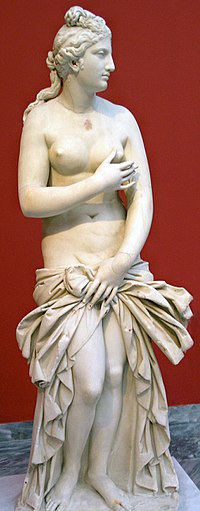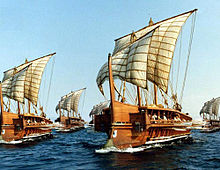|
Greek city of Phanagoria (as Agrippia) in Pontus
Bronze 21mm (6.16 grams) Civic Issue, Struck circa 14-12 B.C.
Reference: MacDonald 275; RPC I 1935; Anokhin 323; SNG Stancomb 631
Certification: NGC Ancients Ch VF 4375823-322
Veiled head of possibly Livia as Aphrodite Urania right.
ΑΓΡΙΠΠΕΩΝ, Prow of galley left; H to right.
In the first century A. D. Phanagoria appears to have borne the name of Agrippia Caesarea (see Pauly-Wissowa, s. v.).
Phanagoria. The chief city of Asiatic Bosporus, situate nearly opposite Panticapaeum, the European capital.
You are bidding on the exact item pictured, provided with a Certificate of Authenticity and Lifetime Guarantee of Authenticity.
 Livia Drusilla, (Classical Latin: LIVIA•DRVSILLA, LIVIA•AVGVSTA) (58 BC–AD 29), after her formal adoption into the Julian family in AD 14 also known as Julia Augusta, was a Roman empress as the third wife of the Livia Drusilla, (Classical Latin: LIVIA•DRVSILLA, LIVIA•AVGVSTA) (58 BC–AD 29), after her formal adoption into the Julian family in AD 14 also known as Julia Augusta, was a Roman empress as the third wife of the
Emperor Augustus and his advisor. She was the mother of the Emperor Tiberius, paternal grandmother of the Emperor Claudius, paternal great-grandmother of the Emperor Caligula, and maternal great-great grandmother of the Emperor Nero. She was deified by Claudius who acknowledged her title of Augusta.
Aphrodite is the Greek goddess of love, beauty, and sexuality. Her Roman equivalent is the goddess Venus. Historically, her cult in Greece was imported from, or influenced by, the  cult of Astarte in Phoenicia. cult of Astarte in Phoenicia.
According to Hesiod‘s Theogony, she was born when Cronus cut off Uranus‘ genitals and threw them into the sea, and from the sea foam (aphros) arose Aphrodite.
Because of her beauty other gods feared that jealousy would interrupt the peace among them and lead to war, and so Zeus married her to Hephaestus, who was not viewed as a threat. Aphrodite had many lovers, both gods like Ares, and men like Anchises. Aphrodite also became instrumental in the Eros and Psyche legend, and later was both Adonis‘ lover and his surrogate mother. Many lesser beings were said to be children of Aphrodite.
Aphrodite is also known as Cytherea (Lady of Cythera) and Cypris (Lady of Cyprus) after the two cult-sites, Cythera and Cyprus, which claimed her birth. Myrtles, doves, sparrows, horses, and swans are sacred to her. The Greeks further identified the Ancient Egyptian goddess Hathor with Aphrodite.[4] Aphrodite also has many other local names, such as Acidalia, Cytherea and Cerigo, used in specific areas of Greece. Each goddess demanded a slightly different cult but Greeks recognized in their overall similarities the one Aphrodite. Attic philosophers of the fourth century separated a celestial Aphrodite (Aprodite Urania) of transcendent principles with the common Aphrodite of the people (Aphrodite Pandemos).
 A galley is a type of ship propelled by rowers that originated in the eastern Mediterranean Sea and was used for warfare, trade and piracy from the first millennium BC. Galleys dominated naval warfare in the Mediterranean from the 8th century BC until development of advanced sailing warships in the 17th century. Galleys fought in the wars of Assyria, ancient Phoenicia, Greece, Carthage and Rome until the 4th century AD. After the fall of the Western Roman Empire galleys formed the mainstay of the Byzantine navy and other navies of successors of the Roman Empire, as well as new Muslim navies. Medieval Mediterranean states, notably the Italian maritime republics, including Venice, Pisa, Genoa and the Ottoman Empire relied on them as the primary warships of their fleets until the 17th century, when they were gradually replaced by sailing warships. Galleys continued to be applied in minor roles in the Mediterranean and the Baltic Sea even after the introduction of steam propelled ships in the early 19th century. A galley is a type of ship propelled by rowers that originated in the eastern Mediterranean Sea and was used for warfare, trade and piracy from the first millennium BC. Galleys dominated naval warfare in the Mediterranean from the 8th century BC until development of advanced sailing warships in the 17th century. Galleys fought in the wars of Assyria, ancient Phoenicia, Greece, Carthage and Rome until the 4th century AD. After the fall of the Western Roman Empire galleys formed the mainstay of the Byzantine navy and other navies of successors of the Roman Empire, as well as new Muslim navies. Medieval Mediterranean states, notably the Italian maritime republics, including Venice, Pisa, Genoa and the Ottoman Empire relied on them as the primary warships of their fleets until the 17th century, when they were gradually replaced by sailing warships. Galleys continued to be applied in minor roles in the Mediterranean and the Baltic Sea even after the introduction of steam propelled ships in the early 19th century.
The galley engagements at Actium and Lepanto are among the greatest naval battles in history.
Phanagoria (Ancient Greek: Φαναγόρεια Phanagóreia) was the largest ancient Greek city on the Taman peninsula, spread over two plateaus along the Asian shore of the Cimmerian Bosporus. The city was a large emporium for all the traffic between the coast of the Maeotian marshes and the countries on the southern side of the Caucasus. It was the Asian capital of the Bosporan Kingdom, with Panticapaeum being the European capital. Strabo described it as a noteworthy city which was renowned for its trade. Today the site is located at a short distance to the west of Sennoy in Krasnodar Krai, Russia. Another ancient Greek city, Hermonassa, lies 25 kilometres (16 mi) to the west, on the shoreline of modern Taman.
Phanagoria was founded ca. 543 BC by the Teian colonists who had to flee Asia Minor in consequence of their conflict with Cyrus the Great. The city took its name after one of these colonists, Phanagoras. “The unusual nature of the Taman peninsula near Phanagoria, with its ravines, crevices, hills, and low cones of active volcanoes, must have impressed the ancient colonists even more than it impresses us today”, Ustinova has observed.
In the 5th century BC, the town thrived on the trade with the Scythians and Sindi. Located on an island in the ancient archipelago of Corocondamitis, between the Black Sea and the Palus Maeotis, Phanagoria covered an area of 75 hectares (190 acres) of which one third has been submerged by the sea. In the early 4th century BC the burgeoning Bosporan Kingdom subjugated much of Sindica, including the independent polis of Phanagoria. The town’s importance increased with the decline of the old capital, Panticapaeum, situated on the opposite shore of the Bosporus. By the first centuries AD, Phanagoria had emerged as the main centre of the kingdom.
During the Mithridatic Wars, the town allied with the Roman Republic and withstood a siege by the army of Pharnaces II of Pontus. It was at Phanagoria that the insurrection broke out against Mithridates VI of Pontus, shortly before his death; and his sons, who held the citadel, were obliged to surrender to the insurgents. An inscription found during excavations testifies that Queen Dynamis honored Augustus as “the emperor, Caesar, son of god, the god Augustus, the overseer of every land and sea”. The loyalty to Rome allowed Phanagoria to maintain a dominant position in the region until the 4th century, when it was sacked and destroyed by the invading Huns.
|








 Livia Drusilla, (Classical Latin: LIVIA•DRVSILLA, LIVIA•AVGVSTA) (58 BC–AD 29), after her formal adoption into the Julian family in AD 14 also known as Julia Augusta, was a Roman empress as the third wife of the
Livia Drusilla, (Classical Latin: LIVIA•DRVSILLA, LIVIA•AVGVSTA) (58 BC–AD 29), after her formal adoption into the Julian family in AD 14 also known as Julia Augusta, was a Roman empress as the third wife of the  cult of Astarte in Phoenicia.
cult of Astarte in Phoenicia. A galley is a type of ship propelled by rowers that originated in the eastern Mediterranean Sea and was used for warfare, trade and piracy from the first millennium BC. Galleys dominated naval warfare in the Mediterranean from the 8th century BC until development of advanced sailing warships in the 17th century. Galleys fought in the wars of Assyria, ancient Phoenicia, Greece, Carthage and Rome until the 4th century AD. After the fall of the Western Roman Empire galleys formed the mainstay of the Byzantine navy and other navies of successors of the Roman Empire, as well as new Muslim navies. Medieval Mediterranean states, notably the Italian maritime republics, including Venice, Pisa, Genoa and the Ottoman Empire relied on them as the primary warships of their fleets until the 17th century, when they were gradually replaced by sailing warships. Galleys continued to be applied in minor roles in the Mediterranean and the Baltic Sea even after the introduction of steam propelled ships in the early 19th century.
A galley is a type of ship propelled by rowers that originated in the eastern Mediterranean Sea and was used for warfare, trade and piracy from the first millennium BC. Galleys dominated naval warfare in the Mediterranean from the 8th century BC until development of advanced sailing warships in the 17th century. Galleys fought in the wars of Assyria, ancient Phoenicia, Greece, Carthage and Rome until the 4th century AD. After the fall of the Western Roman Empire galleys formed the mainstay of the Byzantine navy and other navies of successors of the Roman Empire, as well as new Muslim navies. Medieval Mediterranean states, notably the Italian maritime republics, including Venice, Pisa, Genoa and the Ottoman Empire relied on them as the primary warships of their fleets until the 17th century, when they were gradually replaced by sailing warships. Galleys continued to be applied in minor roles in the Mediterranean and the Baltic Sea even after the introduction of steam propelled ships in the early 19th century.




